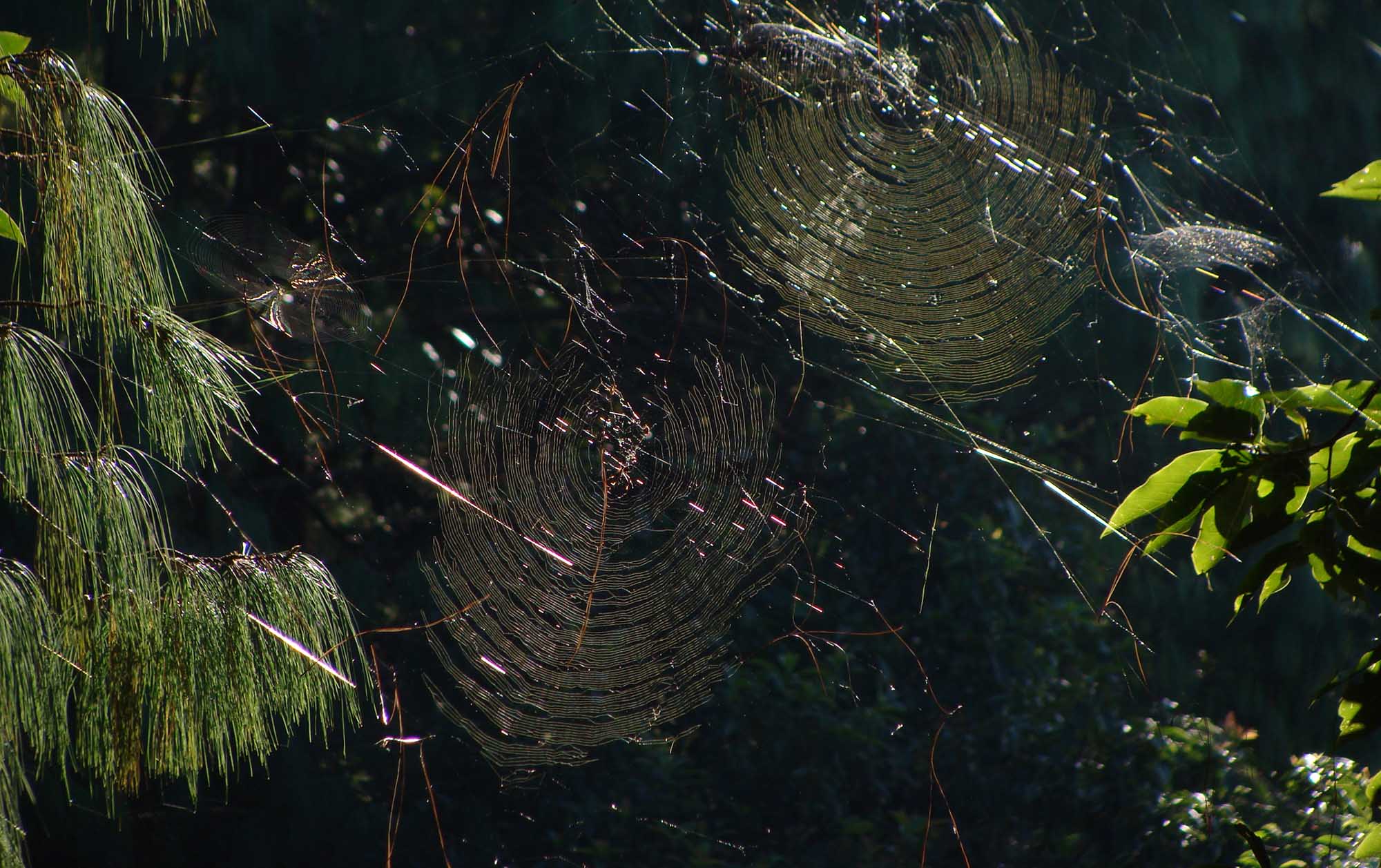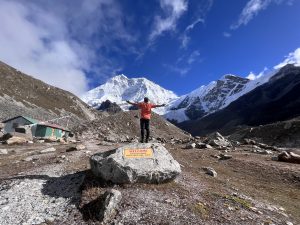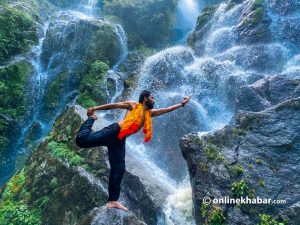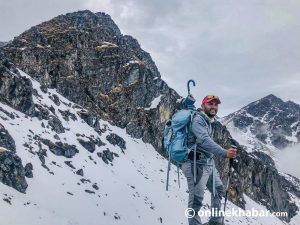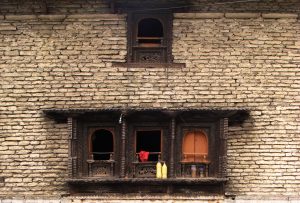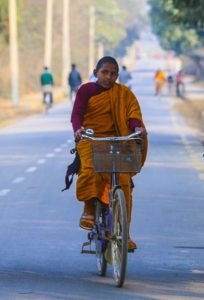Shivapuri Hill, at least for me, has a magnetic pull. I sometimes catch a glimpse of it from a high point south of the Bagmati and feel a pang for the wilderness. If there has been a shower in the afternoon, the day’s last light turns it into the color of burnished copper, and the whole hill face becomes a huge hoarding board for wilderness.
And then the sight slips away as I descend into the snarl of Kathmandu’s traffic, to resume the daily struggles in the Valley floor. I must go there more often, I tell myself as I hang out the laundry on the terrace, and know at the back of my mind that I won’t anytime soon. But even without going there I feel there is something good in the air as long as there is forest cover on that hill.
Nature is tremendously lovable, but it’s a love that needs renewal, especially when you are trapped for days and weeks in the concrete labyrinth. Shivapuri is no exception to this. But it’s amazing that Kathmanduites prefer to wait for their long-desired trip to Chitwan National Park to happen rather than go to Shivapuri.
There are not many capital cities in the world that have a national park within an hour’s drive from its downtown, one outdoor sports business operator and long-time Shivapuri aficionado once reminded me. Perhaps that is why no one wants to go there. The idea of wilderness is inextricably – and in some people’s mind unalterably – bound to remoteness.
Shivapuri?
People give a dismissive laugh and go back to perusing blogs on Langtang National Park and Bardia’s jungles. Better to let plans for trips gather dust than to set foot on the quiet trails of a national park in your backyard.
You won’t see herds of wildlife in Shivapuri like you might in Chitwan. But that is not what you go there for. You go for the quiet. To hear brooks, and see a tiny crab on its edge, holding up his pincers like a boxer’s fists. There is birdsong, and the sudden rustling and scuttling and crashing made by spooked animals.
Ties with the sights and sounds and pace of life Kathmanduites are accustomed to are severed as soon as you enter the park at Pani Muhan, which is north of the famed temple of Budhanilkantha. Birdsongs seem to drip down on you. Trees arch over the graveled road, keeping it dank and dark year round. You hear the gurgling of streams long before you see them. A couple of times, there is a gap in the corridor of trees and you get a glimpse of Kathmandu. Then the trail snakes into the bowels of the forest again and all is green and quiet and smells of earth.
If you look up east from the clearing on the trail from where Kathmandu is visible, you see several slightly curved colorful strips. They are the prayer flags of the Nagi Gompa. When you look at Shivapuri from the Valley floor, the white block you see is this nunnery. It’s a sacred place, and people come here from all over Kathmandu. But for those who profess allegiance to the outdoors or have forsaken their devotion, if only for a day, to the frenetic faith called city life, this is simply a place to breathe in the mountain air, while away time in the dappled shade of a prayer flag-smothered tree or follow the eagles that seem to always hang around. Most times, all this happens with the soothing sound of dozens of nuns chanting mantras in the prayer hall in the background.
The monastery is also a resting place for those whose destination is Shivapuri’s peak (2,732m). Hikers, bikers and devotees have taken the wild edge off the section up to Nagi Gompa, but the trail up from there is wilder. Moisture and moss are everywhere. Old man’s beard dangles from tree limbs, giving the forest an eerie look, which is exacerbated by the faint light. It’s a lonely stretch, and a long walk to the next semblance of a human settlement.
It’s a bit of an exaggeration to call the two huts and a tiny stupa a settlement, but in the heart of the Shivapuri forest, out of view of any other place, the structures lift your soul. There is water and tea—if the occupants, a motley band of ascetics and laymen, are around. The peak is another half an hour’s taxing climb from there.
Shivapuri’s peak is an inviolate clearing in the forest. A shrine to the revered ascetic Shivapuri Baba sits in one corner. Across the clearing from it is an abandoned army post, a casualty of the civil war. A little below this ruin is a rock jutting out of the hill. It is to stand on this three foot ledge that hikers toil for hours.
When you lift your eyes north and see the snowy peaks against the blue skies your spirit is lifted too in knowing that there is a tiny spot near Kathmandu where you can come to renew your love affair with Nature.
While in Shivapuri
A Brief History

Shivapuri National Park’s history began in the head of a high-ranking Rana, possibly the prime minister. It’s easy to picture the man gazing out of his palace window one day and his heart yearning for a hunting trip to the forested hill dominating the northern wall of the Valley. Or perhaps courtiers eager to please brought word of the forest to the north that was teeming with wild animals.
Whatever it was, Shivapuri became a hunting destination for the Ranas, who brought teams of dogs and servants to flush out their quarries. They wanted the abundance of wildlife only for themselves, so the forest was declared a private hunting reserve.
So Shivapuri was saved from the growing city’s ravenous appetite for timber by default. Further protection came in 1975, when the Shivapuri Watershed Development Board bestowed on it the status of a protected area. Shivapuri’s survival as a green haven was guaranteed in 2003, when it was declared a national park.
Adventures Galore
Shivapuri National Park covers an area of 159 square kilometers. This is one big playground for outdoor enthusiasts, whether they are into hiking, mountain biking, trail running, camping, birdwatching or rock climbing. There are even the lesser known sports of canyoning and bouldering.
Hiking

If you like hiking, you will love Shivapuri. There are several destinations that you can hike to, depending on your walking speed and stamina. Nagi Gompa, which is 3 km from the park entrance at Pani Muhan, is ideal for a relaxed walk in the woods. Hardy walkers can go all the way up to the Shivapuri Peak, which will bring views of mountains hovering over mist.
There is also Bagdwar, the Bagmati’s source. Then there is a long hike that covers the breath of the national park, from Pani Muhan to Chisapani, the village on the popular Gosainkunda trek.The “Café Behind the House” (name translated from Nepali) is the place to get your fix of Newar cuisine. Also try the local yogurt while in Dhulikhel. Several of the tea shops keep a stock.
Birdwatching

Birds are the first ones to welcome you to the forest. It takes more effort to not be a birder in Shivapuri than being one. The park is home to species like the Hill Partridge, Wedge-tailed Green Pigeon, Kalij Pheasant, Nepal Fulvetta, Asian Paradise-flycatcher, Rufous-bellied Woodpecker, Mountain Scops Owl, Yellow-bellied Bush Warbler, Maroon-backed Accentor and Grey-winged Blackbird. A total of 318 species have been recorded in the park, including Nepal’s only endemic bird, the Spiny Babbler.If it is seclusion and sweeping mountain views you are in Dhulikhel for, then the Dhulikhel Village Resort is hard to beat. If you are on a small budget, the Langtang View Resort is a good choice.
Canyoning

Canyoning is fun in the form of water and slippery rock. Take any of Chhango’s, the only company offering canyoning trips in Shivapuri, several packages, and expert guides will take you down one waterfall after another on a rope.
Photography

Shivapuri has 19 species of mammals, including the rare clouded leopard. The park also has 102 species of butterflies. This faunal richness combined with the magnificent mountain panorama visible from Shivapuri peak makes the park a wonderful destination for photography.
Caution!

The Nagi Gompa and nearby areas are terrorised by rapacious monkeys who are in the habit of snatching food from people. There have been cases of monkeys biting people to get their food, so never open food packages while in this area or when monkeys are around.
***
More short trips around Kathamndu
Here’s how you can escape Kathmandu, without leaving it!
Dhulikhel: At historical Nepal-China trade town Himalayan panorama is successful commodity
Mountain Retreat in Namo Buddha
The rustic utopia that is Dandagaon



